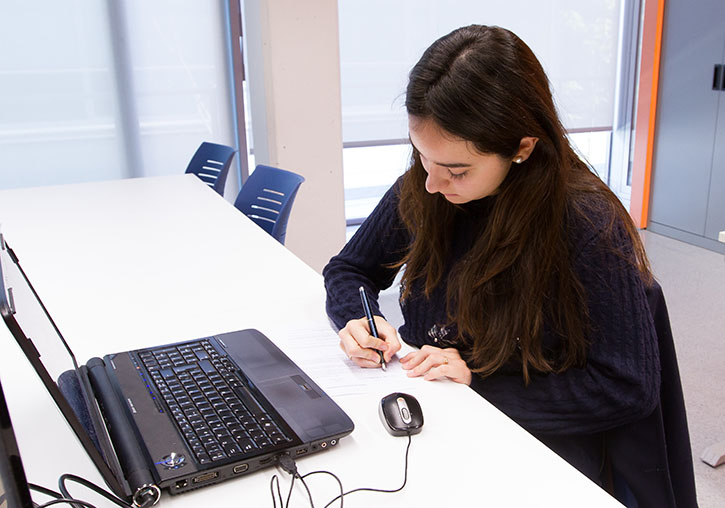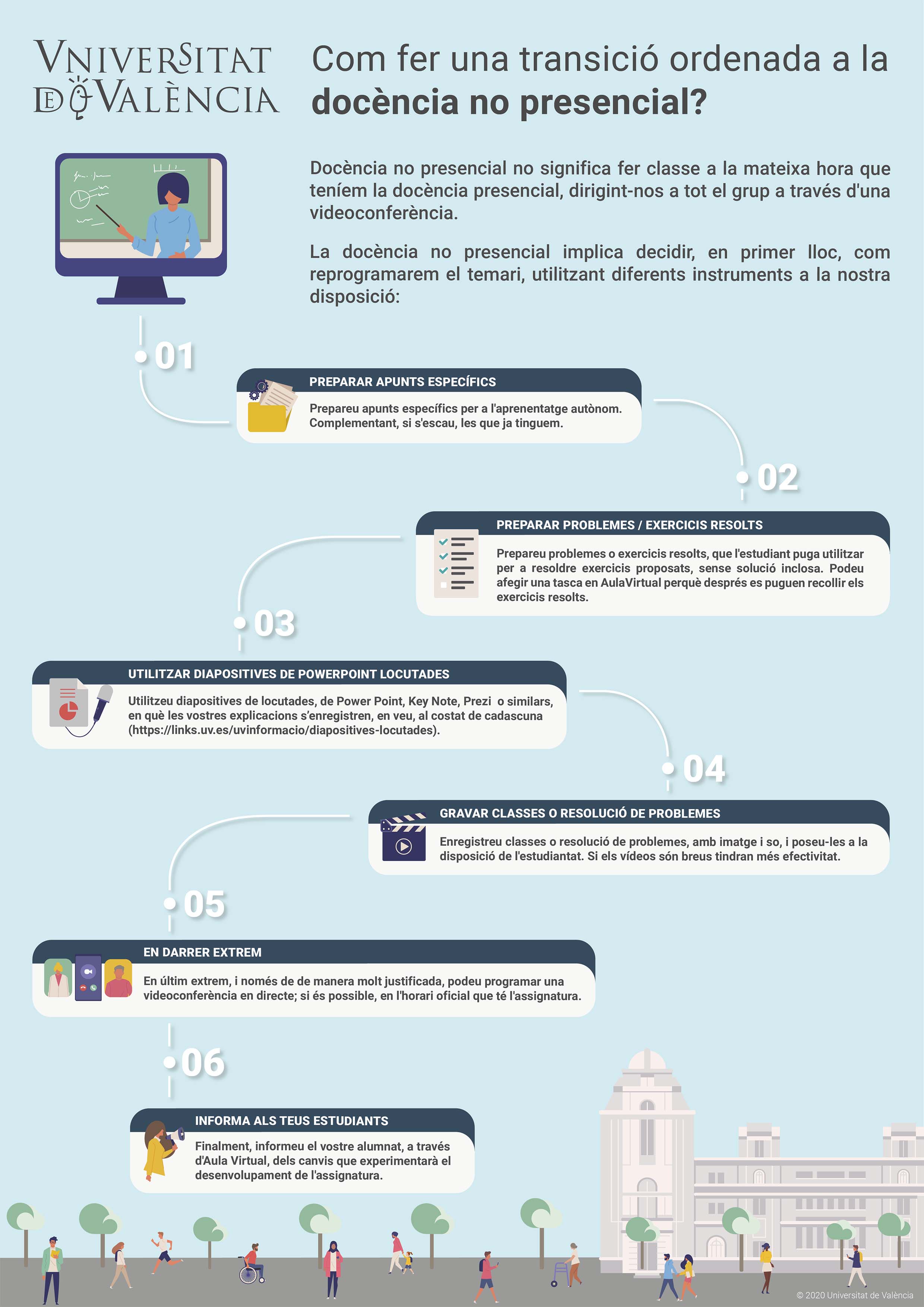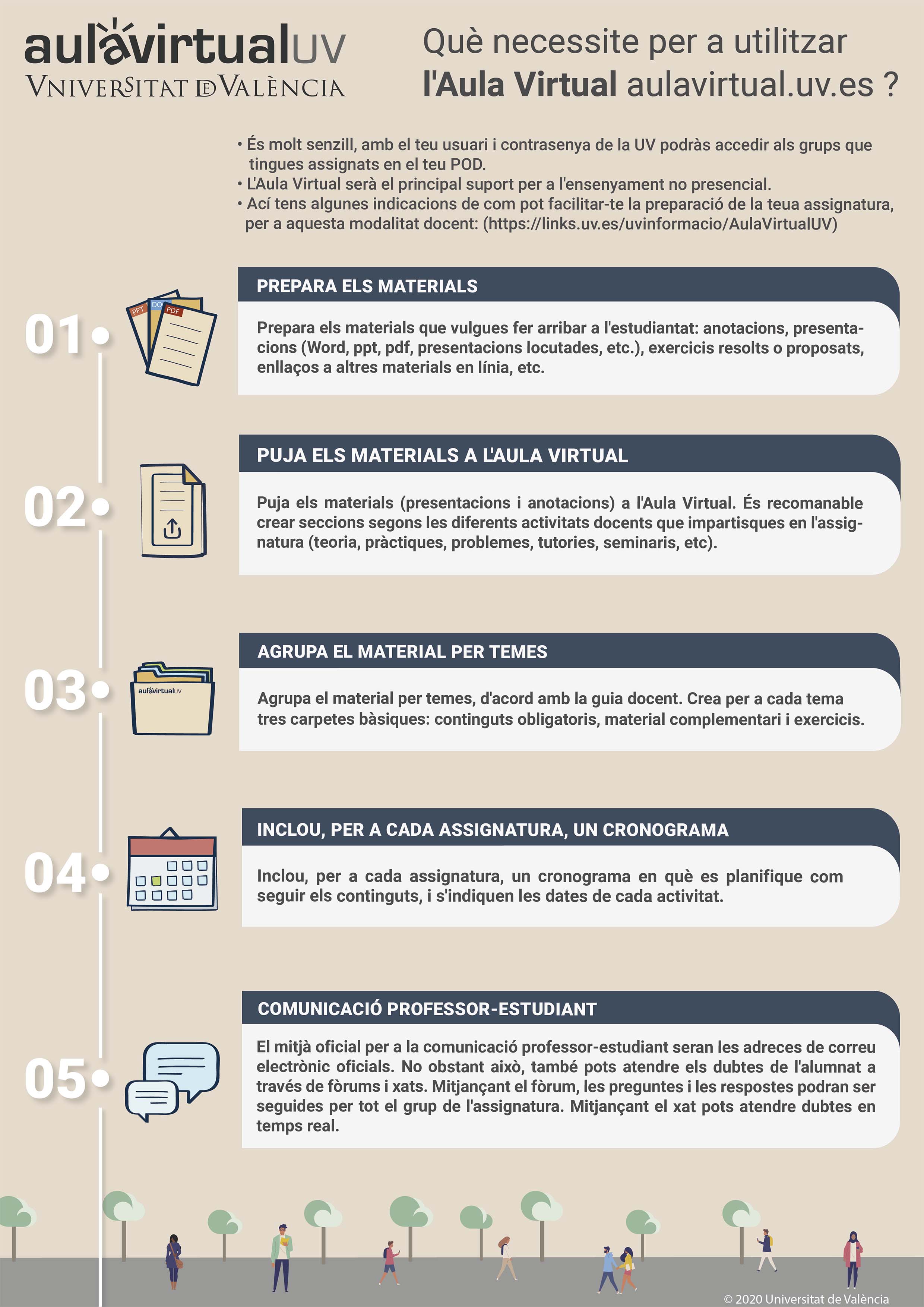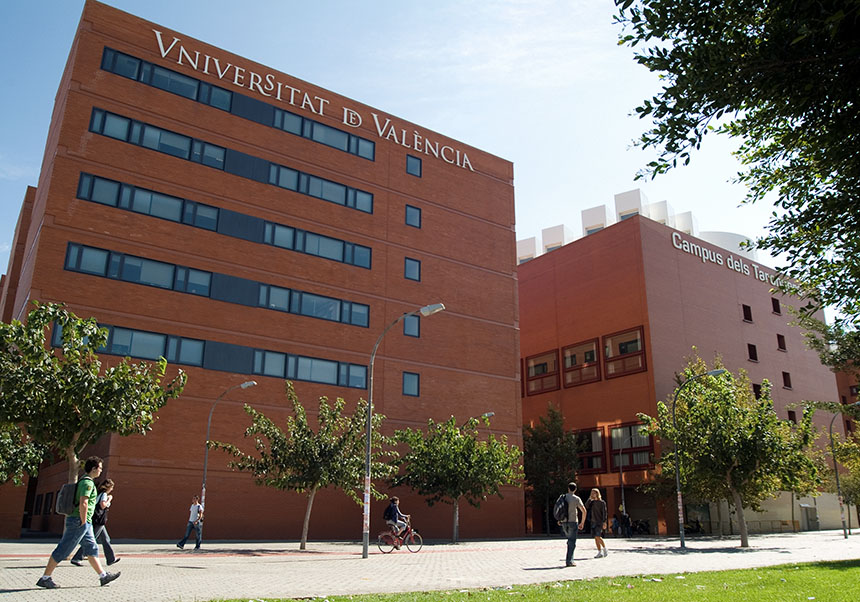Realising online teaching activities
- Office of the Principal
- March 20th, 2020

Government measures regarding the state of emergency presuppose online teaching activities. What does this mean? How can this measure be implemented? This article addresses the issue of challenging transition to online teaching in an organised manner and with the resources available at the Universitat.
On 12 March, the Valencian Ministry of Public Health adopted a resolution (2020/2526) according to which all university educational and teaching activities are suspended in all centres and studyy cycles, degrees, courses, and teaching levels of the Valencian Community as a result of the evolution of COVID-19.
The decision of the Valencian government (Generalitat Valenciana) came into effect on 16 March and extended the Spanish Royal Decree 463/2020 published on 14 March by the Spanish government. This decree declared the state of emergency and presupposed the suspension of all on-site teaching activities as one of the restraint measures in the field of education. It also established that during the restraint period, “teaching activities will be maintained with the help of online tools whenever possible.”
To organise this swift to online teaching, the Valencian Ministry of Innovation, Universities, Science and Digital Society published a resolution (2020/2544) on 13 March, establishing that “those in charge of university centres, departments, and institutes should coordinate with the existing structures of each university on the matter of information technologies in an adequate way.”
But how to ensure a smooth and organised transition to online teaching? This article aims to clarify the doubts and bring to the attention of the university community some technological resources available at the Universitat de València to address this challenge.
First, it is important to clarify that online teaching does not mean holding the class at the time of the usual schedule.
It also does not mean giving classes via videoconference.
So what does it mean? It means that the teaching staff should review the programme of their courses.
The Office of the Vice-Principal for Employment and Training Services and specifically Research and Innovation Service (SFPiE) advise to review the course programme using various tools available at the university.
Here are five pieces of advice:
- Prepare specific notes for autonomous leaning
- Prepare the problems and exercises with ready-made solutions
- Use presentations with a voice-over
- Record class videos or problem solutions
- Stream classes online
Prepare specific notes for autonomous leaning
The majority of courses has already offered the notes for students via the Virtual Classroom. Now it is the time to complement them so that the students can follow the programme in the format of notes.
It is important to note that with the suspension of classroom activities and the subsequent closure of the university owing to the state of emergency, the libraries will be closed as well. Therefore, access to books and manuals is limited to the online resources of the UV libraries.
Prepare the problems and exercises with ready-made solutions
In addition to presenting the students with the exercises, it is highly recommended to upload similar problems with ready-made solutions to them. This way, the students will have a guide to resolve the problem, which is a part of online teaching activities.
The taskbar of the UV Virtual Classroom allows the students to submit a completed exercise within a certain deadline for the teacher to check them.
Use presentations with a voice-over
The teachers of many courses offer the students their presentations used in class.
This new mode of online teaching can incorporate a voice recorder over the presentations previously prepared for the traditional methods of teaching.
In case a teacher uses Power Point slides, they can access a Microsoft tutorial on how to add a voice over the presentation: http://links.uv.es/tp/pp-locutadas
Record class videos or problem solutions
This is a one step ahead in online teaching, but is surely not obligatory. It requires advanced skills and availability of means that allow recording videos of high audio and video quality.
SFPiE recommends that the teachers willing to impart such classes record them in short videos, which proved to be more effective.
Stream classes online
The Office of the Vice-Principal for Employment and Training Services as well as the Office of the Vice-Principal for Strategy, Quality and Information Technologies recommend that live streaming be used as the last resource and only if justified.
Why? It has a technological explanation at the national level of Spain.
The need for responsible use of communication networks to stop the increase in data traffic
Why is the limited use of videoconferences recommended? The response relates to the issue of technology which ganed much visibility in media: Telephone carriers claim that Spain has seen a 40% spike in traffic through IP networks and a 25% increase in the use of mobile data.
The spike in network traffic is associated with remote work, so Internet operators Movistar, Orange, Vodafone, Grupo Masmovil, and Grupo Euskaltel recommend:
- Download only the necessary documents and files at the time of lowest traffic flow, if possible (from 8 p.m. to 8 a.m. and from 2 p.m. to 4 p.m.);
- Avoid sending large files or big e-mails;
- Take advantage of file sharing tools.
One of the file sharing tools that the Computer Service of the Universitat de València offers is the Virtual Classroom which should be of help for online teaching.
Virtual Classroom as the tool for online teaching
Office of the Vice-Principal for Strategy, Quality and Information Technologies outlines the simple interface of the Virtual Classroom so that the teachers can access all the groups of their courses only with their username and the password.
Together with SFPiE and the Computer Service, the offices of the vice-principals have released a set of recommendations:
First, to prepare materials that the teacher wants to send to the students (notes, presentations, exercises, links to online sources);
Second, to publish the materials in the Virtual Classroom. It is advisable to create sections according various activities (theory, practice, problems, tutorship, workshops, etc.);
Third, to group the material by topics in line with the course guides. It is advisable to create three basic folders for each topic: compulsory readings, complementary material, and exercises.
Fourth, to include a schedule that outlines how a student should follow the published material and the dates for each activity.
The information about the use of the Virtual Classroom of the Computer Service can be found following the link: http://links.uv.es/3LMOpNG
Publication of video contents
The Computer Service recommends publishing the video content in Mmedia repository.
Other social video platforms, like YouTube, Vimeo, MS Streams, and Dailymotion may also be used.
To optimise the use of networks, it is recommended to upload files of less than 250Mb.
Following this link, you can access the suggesstions of the Computer Service regarding video contents: http://links.uv.es/q6qB4y3
How to handle professor-student communication
It is important for the professors to share all information related to the development of online teaching activities. For this, Virtual Classroom offers the options of forums, chats, and tasks.
In forums, all course groups can follow the question and answer threads.
Chats allow for real-time clarification of doubts.
Both chats and tasks ensure that notifications are sent to the students and the professors e-mails, so there is no need to log in the Virtual Classroom all the time.
Microsoft Teams may be used for tutorship and group works, and Blackboard might be employed during videoconferences unless other tools allow to achieve the goal.
In addition, e-mail service of the Universitat de València permits establishing a direct contact with professors. The Universitat de València recommends that the students use their institutional e-mail accounts; this way, they can be easily identified as members of the university community.
__
This information was elaborated as a part of institutional communication on behalf of the Principal’s Office of the Universitat de València. It is based on the document of the Office of the Vice-Principal for Employment and Training Services “How to ensure a smooth and organised transition to online teaching?”, which may be accessed here (in Spanish): http://links.uv.es/EiR0MhG
Additional information:
Online access to the support team of the UV Computer Service
Tutorials in Spanish: http://links.uv.es/X0kqHfs
Tutorials in Valencian: http://links.uv.es/a2WoOdY
File in:




















